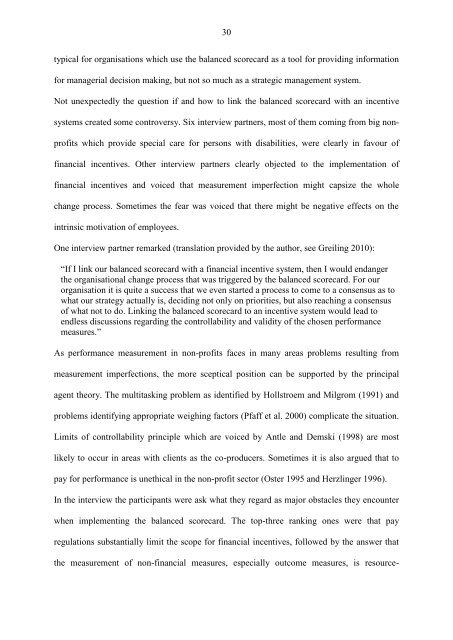Strategic responses to Performance Measurement in Nonprofit ...
Strategic responses to Performance Measurement in Nonprofit ...
Strategic responses to Performance Measurement in Nonprofit ...
Create successful ePaper yourself
Turn your PDF publications into a flip-book with our unique Google optimized e-Paper software.
30<br />
typical for organisations which use the balanced scorecard as a <strong>to</strong>ol for provid<strong>in</strong>g <strong>in</strong>formation<br />
for managerial decision mak<strong>in</strong>g, but not so much as a strategic management system.<br />
Not unexpectedly the question if and how <strong>to</strong> l<strong>in</strong>k the balanced scorecard with an <strong>in</strong>centive<br />
systems created some controversy. Six <strong>in</strong>terview partners, most of them com<strong>in</strong>g from big non-<br />
profits which provide special care for persons with disabilities, were clearly <strong>in</strong> favour of<br />
f<strong>in</strong>ancial <strong>in</strong>centives. Other <strong>in</strong>terview partners clearly objected <strong>to</strong> the implementation of<br />
f<strong>in</strong>ancial <strong>in</strong>centives and voiced that measurement imperfection might capsize the whole<br />
change process. Sometimes the fear was voiced that there might be negative effects on the<br />
<strong>in</strong>tr<strong>in</strong>sic motivation of employees.<br />
One <strong>in</strong>terview partner remarked (translation provided by the author, see Greil<strong>in</strong>g 2010):<br />
“If I l<strong>in</strong>k our balanced scorecard with a f<strong>in</strong>ancial <strong>in</strong>centive system, then I would endanger<br />
the organisational change process that was triggered by the balanced scorecard. For our<br />
organisation it is quite a success that we even started a process <strong>to</strong> come <strong>to</strong> a consensus as <strong>to</strong><br />
what our strategy actually is, decid<strong>in</strong>g not only on priorities, but also reach<strong>in</strong>g a consensus<br />
of what not <strong>to</strong> do. L<strong>in</strong>k<strong>in</strong>g the balanced scorecard <strong>to</strong> an <strong>in</strong>centive system would lead <strong>to</strong><br />
endless discussions regard<strong>in</strong>g the controllability and validity of the chosen performance<br />
measures.”<br />
As performance measurement <strong>in</strong> non-profits faces <strong>in</strong> many areas problems result<strong>in</strong>g from<br />
measurement imperfections, the more sceptical position can be supported by the pr<strong>in</strong>cipal<br />
agent theory. The multitask<strong>in</strong>g problem as identified by Hollstroem and Milgrom (1991) and<br />
problems identify<strong>in</strong>g appropriate weigh<strong>in</strong>g fac<strong>to</strong>rs (Pfaff et al. 2000) complicate the situation.<br />
Limits of controllability pr<strong>in</strong>ciple which are voiced by Antle and Demski (1998) are most<br />
likely <strong>to</strong> occur <strong>in</strong> areas with clients as the co-producers. Sometimes it is also argued that <strong>to</strong><br />
pay for performance is unethical <strong>in</strong> the non-profit sec<strong>to</strong>r (Oster 1995 and Herzl<strong>in</strong>ger 1996).<br />
In the <strong>in</strong>terview the participants were ask what they regard as major obstacles they encounter<br />
when implement<strong>in</strong>g the balanced scorecard. The <strong>to</strong>p-three rank<strong>in</strong>g ones were that pay<br />
regulations substantially limit the scope for f<strong>in</strong>ancial <strong>in</strong>centives, followed by the answer that<br />
the measurement of non-f<strong>in</strong>ancial measures, especially outcome measures, is resource-
















